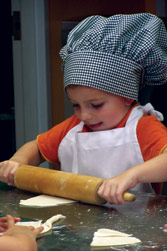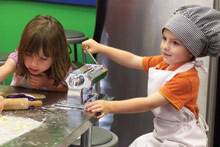Today’s “gastro-kids”—a generation of diminutive epicureans who can knowledgeably critique a recipe before they’re literate enough to read it—have been raised by foodies who’d rather risk their toddlers’ digestive comfort than expose them to an oh-so-unhip medium-well hamburger. These young eaters dote on sushi, goat cheese and quail, among other sophisticated offerings.

But such cosmopolitan foods aren’t exactly economical, leaving today’s parents one more household budget cut to explain to their heartbroken offspring. No, we aren’t going to Disney World this year. No, there won’t be any new toys for Christmas. And, no, we can’t have oysters Rockefeller for dinner.
Yet local experts insist the recession doesn’t have to inhibit young gourmands’ edible educations. While luxury foods may be out of reach, children—and the adults who feed them—can still enjoy healthy, high-quality, haute-ish cuisine on the cheap. Hard-times dining isn’t all chicken nuggets and fast-food value meals: The following tips can help any family eat well on a budget.
The freezer is your friend. The enemy of frugality is waste, and nothing’s more irrevocably wasted than a gallon of milk well past its expiration date. That’s why Tonya Clanton, owner of Growing Young Café in east Asheville, advises grocery shoppers to stock their carts with foods that can be safely stored in the freezer for a very, very long time. “You can buy bagels and just keep them in there,” raves Clanton, whose business includes a large play area for children.
Stop eating so much meat. Most Americans eat way more meat than they should—or so say many dietitians and environmentalists. Meat is also expensive, which is why Grace Singingheart of Arden recommends budget-minded families follow her vegetarian lead. “It’s cheaper all around,” she says. “Beans and rice are a staple for us. We make beans and rice one day; the next day, the leftovers are a casserole with broccoli and cheese.”
Or at least stop eating so much expensive meat. A red-meat craving doesn’t have to be sated by a porterhouse, says Pati Roesler, owner of Young Chef’s Academy in Arden. “Say you’re in the grocery store, and steak’s $12 a pound. If you walk a little further, there’s the rib roast for $4 a pound. Give it to the butcher and ask him to cut it into one-inch steaks,” Roesler suggests.
Cultivate your kid’s inner snob. It seems counter-intuitive, but Roesler gets her students to shun fancy restaurant meals by exposing them as overpriced. “The kids make their own pasta here,” Roesler says. “The thing that I stress is, ‘Look, you can go out and spend $16 for pasta, and it’s still water, flour and eggs. Look how much your pasta costs.’ So we make things a little more inexpensive for parents.”
It’s hard to improve upon an apple. With all the chips and cheese doodles available, millions of Americans still daily snack on fruit. That’s because apples, bananas and grapes are tasty and nutritious: Fruit last year surpassed cookies as the snack most often served to children under 6, according to a report from the retail-marketing giant NPD Group. “We sell a lot of fresh fruit,” confirms Clanton.

Fruit is relatively inexpensive and lends itself to a variety of kid-friendly preparations. Cut up pineapple for a salad, squeeze oranges for a smoothie or bake strawberries into muffins. For an added bonus, consider buying fruit from local farmers at area tailgate markets. And be sure to ask—wink, wink—whether they have any other fruit behind the table: Damaged produce is sometimes offered at a discount.
D.I.Y. groceries. Sometimes a middleman is a wonderful thing. Very few families have the time or inclination to milk their own cows and make their own yogurt (although the few that do are well-represented in Western North Carolina). But other products can be made at home for a fraction of the cost of their mass-marketed equivalents. Singingheart likes to save the heels of bread loaves to make her own bread crumbs for lentil loaf. Granola bars are similarly easy to make: Just mix together oats, honey, brown sugar and butter, and bake.
Child labor works. “I have 4-year-olds cooking dinner for their families,” says Roesler. Appointing a kid as head cook gives parents more time to do other things—such as earn the money to buy the food Junior’s putting on the table. Young children are especially good at making affordable entrees like enchiladas, pizza and macaroni-and-cheese, which Roesler recommends baking in muffin tins. “Kids love it because they’re getting individual portions, and it cooks in 15 minutes instead of an hour-and-a-half, so you’re saving money and energy costs.”



Before you comment
The comments section is here to provide a platform for civil dialogue on the issues we face together as a local community. Xpress is committed to offering this platform for all voices, but when the tone of the discussion gets nasty or strays off topic, we believe many people choose not to participate. Xpress editors are determined to moderate comments to ensure a constructive interchange is maintained. All comments judged not to be in keeping with the spirit of civil discourse will be removed and repeat violators will be banned. See here for our terms of service. Thank you for being part of this effort to promote respectful discussion.